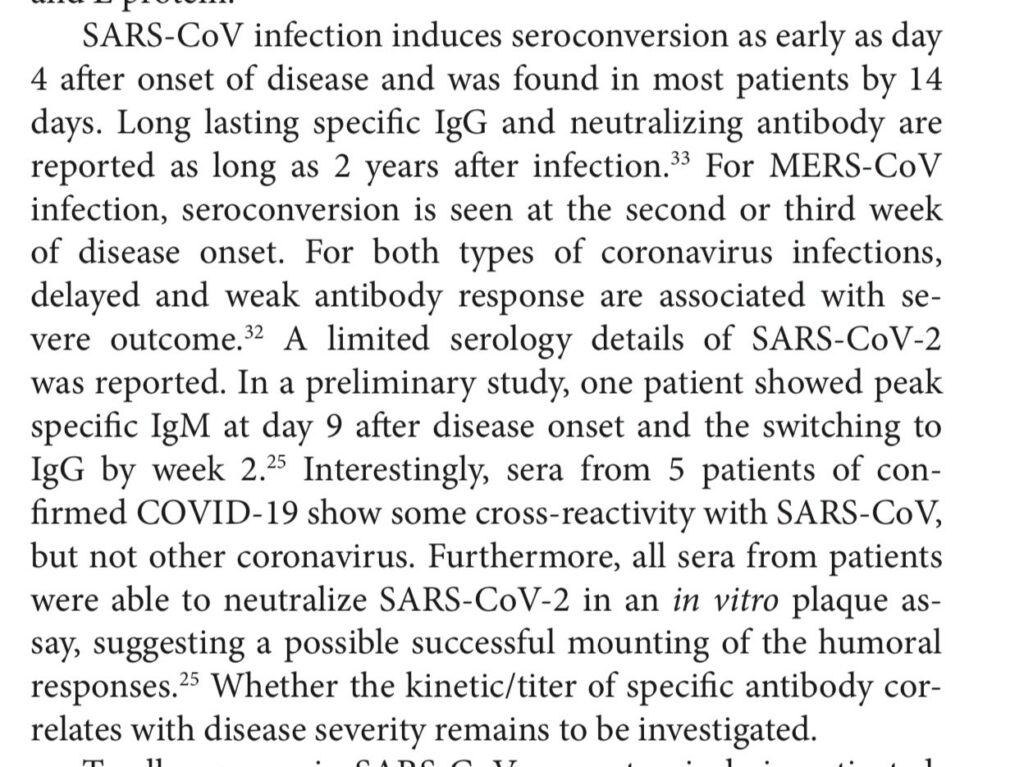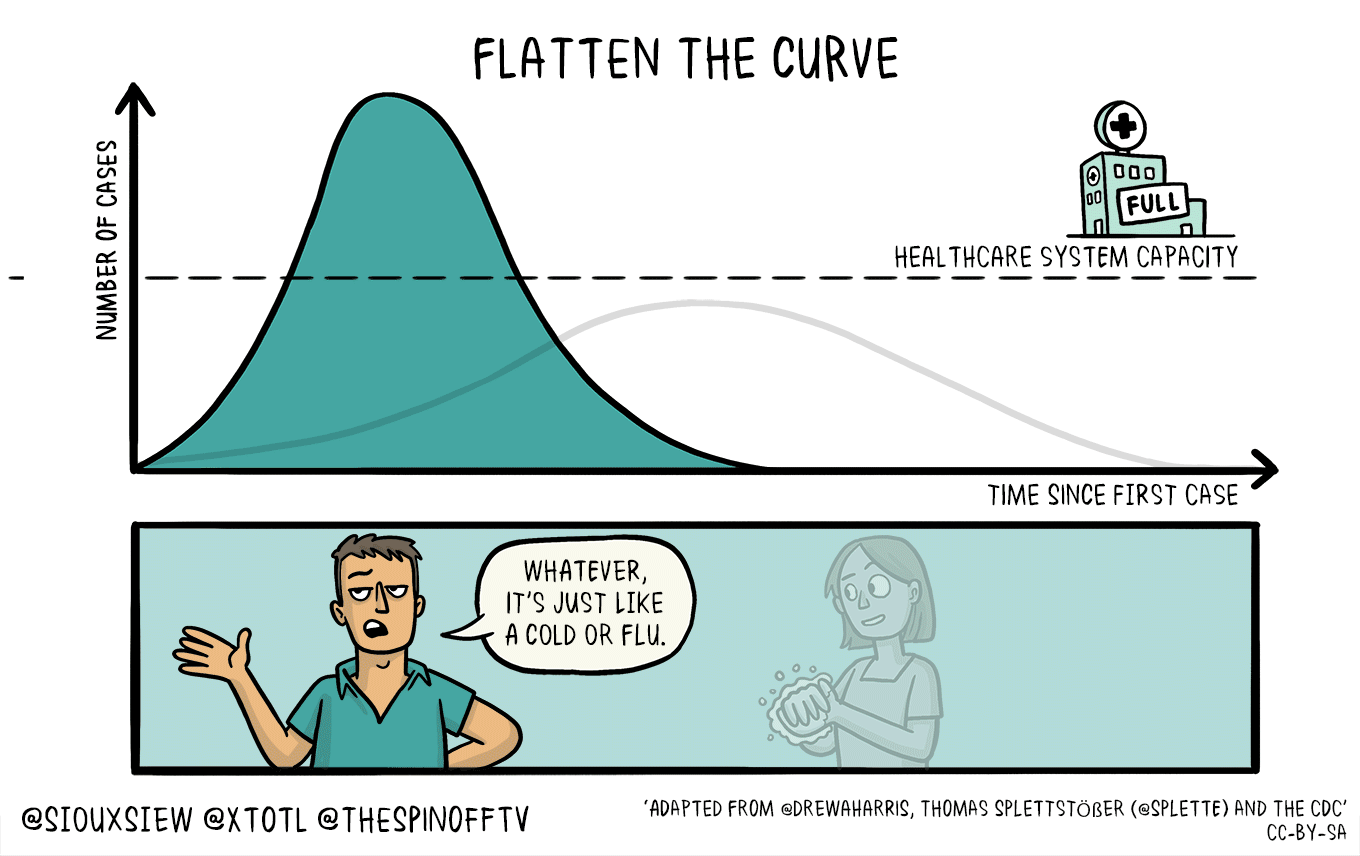Covid-19 is what’s known as a novel coronavirus. Novel as in we’ve never encountered it before, and coronavirus being a specific type of virus. It’s called that because its shape makes it look like a bit like it has crowns on it. It was first discovered in humans at the end of 2019, beginning of 2020.
Here’s how it’s unlike other viruses (like seasonal flu, or the common cold):
After you catch a cold or the flu, your body produces an immune response – first to fight off the virus, and secondly to kill it if it ever pops up in your system again. But because Covid-19 is a new virus to humans, no-one had any natural immunity to it.
That’s the first bad thing.
The second bad thing is its infection rate, known as r0. (Where they come up with these catchy acronyms leaves me baffled.) The r0 is basically the number of other people that someone with the virus is expected to infect, all other things being equal. So a person who’s contracted a virus with an r0 of 1 would be expected to infect one other person, on average. An r0 of 2 would result in two new infections for each person.
If you think about this, it means that anything with an r0 of less than one will tend to die out, because it infects fewer people as time goes on. And anything with an r0 of greater than one will tend to expand. And the higher the r0, the more quickly it will expand.
Have you ever heard the story of the grains of rice and the chessboard?
In ancient China, a servant had done a good deed for her employer, who asked her how she would like to be rewarded. The servant said “I should like enough rice to feed my family.”
“How much is that?” said her employer.
She pointed to the chess board in the corner of the room and said “Today, place a grain of rice on the first square of the chess board, and I will take it home to feed my family.”
“You won’t be able to feed them very well on that,” he replied.
“Tomorrow, place two grains of rice on the second square, and I will take it home to feed my family.”
The employer looked on quizzically.
“Each day, place double the number of rice grains on the next square, and I will take them home to feed my family. After the last square is full, I shall have more than enough rice.”
So the employer, chuckling at how cheaply he was rewarding his servant, placed a grain of rice on the first square, and watched her take it home. The next day, he placed two grains of rice on the second square. On the third day, four grains of rice.
After a week, there were 64 grains of rice on the 7th square. To put that in context, there are about 200 grains of rice in a level teaspoon. Not looking good for the servant this far, is it?
But the number is doubling every day. And don’t forget, there’s all the rice she’s still got at home.
So on the 8th day there’s about half a teaspoon of rice on the square.
On the 9th day, more than a teaspoon.
On the 10th, coming up to a tablespoon.
And each day, the number of grains of rice keeps doubling. Two tablespoons. Four tablespoons. Eight.
After two weeks she takes home about half a kilogram of rice. On the next day after that, a full kilogram. On the 16th day, two kilos. On the 17th, four kilos. And it just keeps growing.
Today, world rice production in a year is approximately 500 million metric tonnes. Our wily servant will have taken that much rice home on day 54, with 10 squares left to go on the chessboard.
(Obviously, though, the employer realised the wisdom of his servant long before that, gave her a promotion, and definitely did not have her killed for being a show-off.)
This is an example of what’s called exponential growth, and this is the problem with Covid-19. Our current best-estimate r0 for Covid-19 is approximately 2.4. And with exponential growth, small differences make a big difference – if our wily servant had asked for 2.4 times the rice grains on each square (let’s pretend that we can sub-divide rice grains for a moment) then she would have surpassed current world production of rice on day 39. In less than two thirds of the time.
So what can we do about it? Let’s just vaccinate everyone, right?
Unfortunately this is where the bit about it being a novel coronavirus comes in. In order to have a vaccine, we need to have samples of the virus. And because it’s never affected humans before, we don’t. It’ll take at least a year, maybe more to develop one.
So should we all just spend our time watching episodes of Survivors and waiting for the end of humanity?
Well, no. Because of immunity.
This isn’t the first coronavirus that humans have had. Like other viruses, those who get better from Covid-19 will develop antibodies that prevent them catching it again. We already know that this happens – this paper has the details, but here’s the important bit:

(IgM is the thing that helps you fight it off in the first place; IgG is the thing that hangs around in your body to fuck the virus up if it ever tries to come back again.)
And it gets better.
Because once a certain number of population can’t catch the virus any more (because they have the relevant antibodies), it becomes almost impossible for the virus to, well, go viral. There just aren’t enough previously-uninfected people for it to spread to, so a few people will get ill, but we never see the exponential growth phase. This is known as herd immunity.
It’s also one of the benefits of vaccination. A vaccine is basically a shitty version of the virus; too rubbish to actually infect you properly, but just good enough to provoke your body into making an immune response so you can’t get the real thing if you’re ever exposed to it.
So despite the fact that it’s a bastard disease, we’ll beat it in the long run. All it needs is time for enough people to acquire immunity that those without will also be protected.
But there’s another problem. Until that happens, people are going to catch Covid-19. And some of those people are going to die. As well as being bastard infectious, it’s a lot more dangerous than the flu, especially to old people.
So the main problem now is that when people catch it, a serious number of them are going to need hospital treatment. And we don’t have enough beds, or intensive care units if they all become sick at the same time.
Which is why we need to flatten the curve.

We don’t need to defeat it now; we just need to keep our health services from being overwhelmed until our bodies defeat it for us. (Or we get a vaccine, which helps that process along – but as mentioned above, given the r0 of Covid-19 and the time to produce a new vaccine, we may well have defeated it already by the time the vaccine is ready.)
So how do we flatten the curve?
The most important measure is known as social distancing. Basically:
- Don’t go anywhere you don’t need to
- If you do go somewhere, stay away from people (about a metre)
If the virus doesn’t have enough people to spread to, its r0 drops. And as we’ve seen earlier, small differences in r0 can lead to big differences in the time it takes for the big numbers to arrive. So work from home if you can, and get your shopping delivered rather than pick it up in person. Right now the most important thing we can do to save lives is just stay the hell away from each other.
If you must go out, wash your hands. As well as being spread by people, the virus can hang around for up to a week on plastic and metal surfaces – you know, like door handles, tables, and so on. But it can’t stand soap. Twenty seconds of washing your hands with warm soapy water will kill any Covid-19 you may have picked up on them from the environment while out-and-about. So make the first thing you do when you arrive anywhere wash your hands.
Doing these things drops the r0 of the virus, means that fewer cases will hit the healthcare system, and that more lives will be saved.
After that, it’s just a matter of waiting it out.